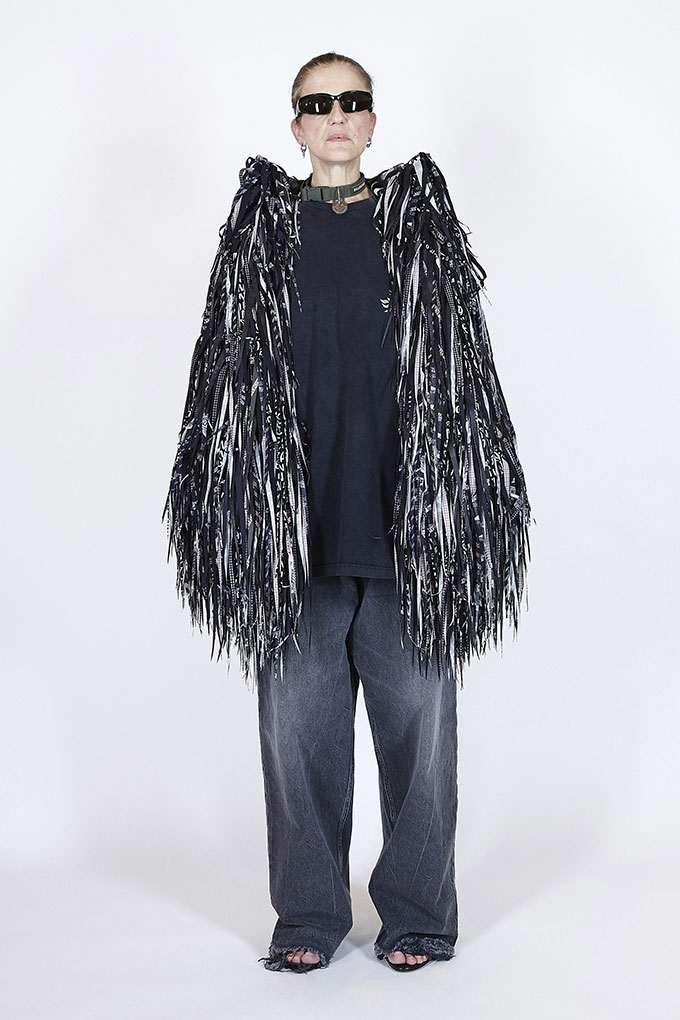Upcycling has been the biggest trend of SS21, with the likes of Balenciaga (see the shaggy coat made from ‘shoelace fur’), Marni (where patchworked outerwear was created from existing garments) and Coach (note the reworked 1970s bags) all exploring how they can reuse materials. Miu Miu, meanwhile, announced in October that it’s launching a new Upcycled collection—an exclusive capsule of 80 one-off dresses, refashioned from antique pieces that have been carefully sourced from vintage stores and markets worldwide.

While young designers such as Priya Ahluwalia, Bethany Williams and Emily Bode have made their names by repurposing textiles that already exist, seeing major luxury brands embracing the practice marks a significant shift within the industry. “The first time we used deadstock and talked about it was in 2017,” Gabriela Hearst, whose SS21 collection contained 60 per cent upcycled pieces, tells Vogue via Zoom. “It was like using a bad word: ‘You don’t say that word in the luxury vocabulary.’”

But the restrictions imposed by the pandemic have led to designers turning to materials they already have to hand in the studio, instead of shipping in new fabrics. JW Anderson recently launched a new capsule collection, Made in Britain, comprising six pieces made purely out of leftover fabrics and trims from previous seasons. “Made in Britain came from this idea during lockdown of creating fashion from what we already had and working locally,” creative director Jonathan Anderson, who has also upcycled pieces for Loewe’s Eye/ Loewe/ Nature collection, explains. “I think we’ll see more and more upcycling in the future.”
The devastating effect of excess inventory
It’s no surprise that more designers are now embracing upcycling, considering the pandemic has led to an eye-watering €140bn to €160bn worth of excess inventory from SS20 collections—more than double the average. In the past, unsold goods would have been burned or thrown away by luxury brands in a bid to preserve their value, as part of a shocking practice that has since been banned in France. As customers become increasingly conscious of wasteful behaviour, it’s more essential than ever that the industry addresses this backlog of garments in a sustainable way.
Duran Lantink, who reassembles deadstock garments from brands including Gucci, Prada, and Off-White into new high-end pieces, has seen a rise in enquiries from major retailers and brands looking to collaborate with him since the pandemic began. “There’s been a lot of interest,” the Dutch designer says via a call from Amsterdam. “It’s kind of scary at the moment—it’s necessary for retailers to think about what to do with deadstock.”
https://www.instagram.com/p/CH-OsnsAH3N/
Naturally, eco-minded designers such as Hearst have taken the problem of excess inventory into their own hands. The New York-based designer recently created the exclusive Retro Fit collection for London’s Selfridges using existing stock—think reworked cashmere, newly dyed shirt dresses and patchwork bucket bags. “When the stores were hit by the pandemic, we started to think, ‘How can we reinvent the inventory that we already have?’” Hearst says.
A new way of working
There are, of course, challenges in factoring in upcycling into the design process. Marine Serre had to completely rethink her production timeline for SS21 after realising it was taking much longer to fulfil orders for her upcycled pieces. “We started working on the garments for the SS21 collection in October 2019, making sure we would have had enough time to produce them properly without squeezing production time,” the French designer told Vogue.
Working from deadstock turns the traditional design process on its head as designers have to commit to their fabrics well in advance—all without knowing how successful the collection will be in terms of purchases. “We’re buying the bulk of the fabric [beforehand], so it has more of a risk on the designer’s part,” Hearst explains, adding: “I enjoy that because it makes you less wasteful.”
Despite the challenges, there are also clear advantages to upcycling, including greater exclusivity. “Once there isn’t any more fabric on the roll, you move on to another leftover roll,” says Danish designer Cecilie Bahnsen, who has started creating Encore collections from surplus materials this year. “It makes the product more exclusive and limited, and adds value.”

While once upon a time, a lack of uniformity would have been a problem for retailers—because the garment that arrives on your doorstep may look different to the piece pictured online—customers are now embracing the uniqueness of the pieces. “The fact that not every piece is identical is exciting for our customer, making it an investment piece, almost collectable,” comments Natalie Kingham, buying director at Matches Fashion, “whether it be a Marine Serre dress crafted from repurposed silk scarves with patterns that differ in each garment, or vibrant wool blankets upcycled into a Rave Review check dress.”
Upcycling needs to be the ‘new normal’
Considering the highest proportion of greenhouse gas emissions from the fashion industry comes from the production of textiles, it’s crucial that reusing materials that already exist becomes common practice. “We have enough textiles that we’ve already produced to last us, and yet we’re still producing masses of clothes from virgin materials,” says Sara Arnold, co-founder of campaign group Fashion Act Now, during a recent Zoom call.
Of course, we can’t simply upcycle our way out of the problem—the fundamental issue of overproduction in the fashion industry needs to be addressed. “It’s important that big retailers reconsider the huge amounts of clothing they are buying,” Lantink comments. “They have to change their mindset.”
Still, seeing major brands finally embrace upcycling can only be a step in the right direction—particularly if it becomes the new normal for fashion. “So many people are getting on board with upcycling now,” Lantink concludes. “It’s hard for brands and retailers to see this as just a trend.”





